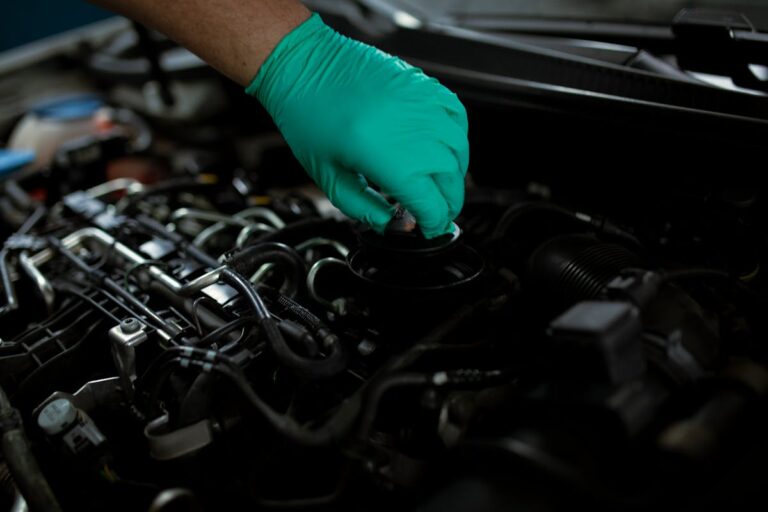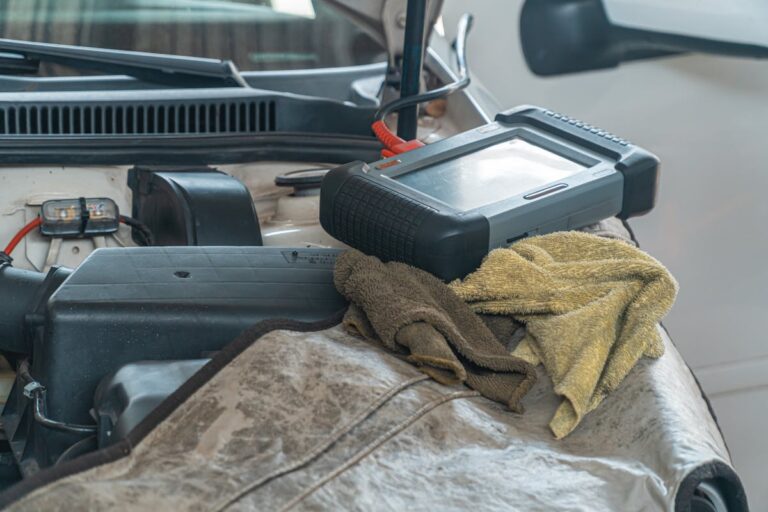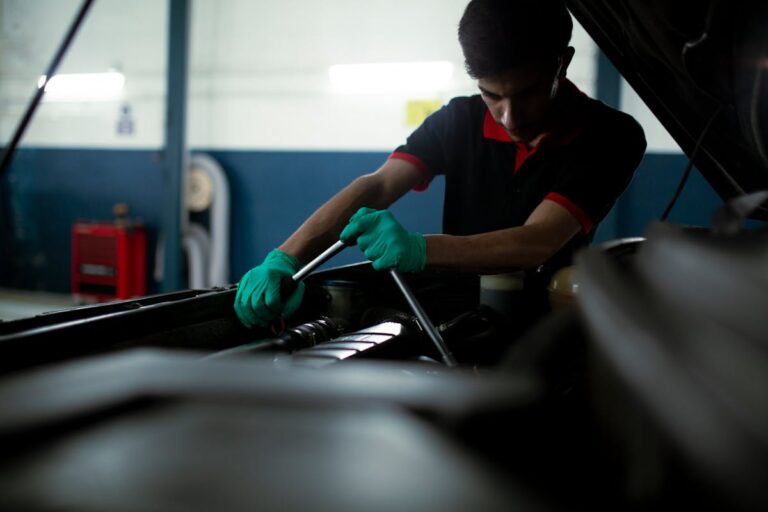In the domain of vehicle maintenance, one area that often presents challenges is the diagnosis and resolution of common auto AC problems. The issues can range from the relatively mundane, such as clogged filters, to more complex concerns like compressor failure or refrigerant leaks. In order to maintain the comfort and functionality of your vehicle, understanding the intricacies of these components and how to identify potential issues is essential. The question, then, becomes: what signs should one look for, and how can these common problems be prevented?
Understanding Auto AC System Basics
If you’ve ever found yourself sweating in your car on a hot day, you’ve likely had a run-in with a malfunctioning auto AC system. Understanding the basics of this system and its key components can help diagnose potential problems and facilitate more effective maintenance.
The auto AC system comprises several primary components, namely the compressor, condenser, expansion valve, and evaporator. Each plays a vital role in the AC refrigerant cycle, a continuous process that allows the system to cool the inside of the vehicle. The compressor pressurizes the refrigerant, turning it into a high-pressure gas. This gas moves to the condenser, where it loses heat and condenses into a high-pressure liquid.
The expansion valve then depressurizes this liquid, turning it into a low-pressure mixture of gas and liquid. The evaporator absorbs heat from the car’s interior, causing this mixture to evaporate back into a gas. This gas returns to the compressor, and the cycle repeats.
Understanding these auto AC components and their roles in the AC refrigerant cycle is a fundamental step in diagnosing common AC problems. This knowledge can help identify issues early on, potentially saving time, discomfort, and costly repairs.
Identifying Unusual AC Noises
Unusual noises emanating from an automobile’s air conditioning system can often be indicative of underlying problems that necessitate immediate attention. These sounds can range from grinding and squealing to rattling, each signifying a distinct issue within the system’s components. Understanding and interpreting these sounds correctly is essential in diagnosing AC problems accurately and efficiently.
Deciphering AC Grinding Sounds
While diagnosing auto AC problems, a common symptom that often causes concern is the presence of unusual noises, particularly a grinding sound. This disconcerting noise is often a clear indication of an underlying mechanical issue which requires immediate attention.
A common cause of grinding noises is the failure of the compressor clutch, a key component responsible for engaging and disengaging the AC compressor. This could be due to normal wear and tear, or it could be an indication of a more serious issue like a damaged or misaligned clutch plate. Regular AC maintenance tips often include inspecting the compressor clutch for signs of wear or damage.
Another potential source of grinding noises is a failing compressor. If the compressor’s internal components start to fail, they may produce a grinding noise as they struggle to function. Similarly, a worn-out AC bearing, which supports the smooth operation of the compressor, can also cause a grinding noise when it begins to fail.
Thus, diagnosing grinding sounds involves a thorough inspection of the AC system. Early detection and intervention through regular maintenance can prevent further damage and costly repairs. Remember, the key to avoiding such issues is proactive and regular AC maintenance.
Unraveling Squealing Noise Issues
Moving from grinding sounds, another auditory symptom that may indicate an auto AC problem is a squealing noise. This sound can be particularly distressing as it is often loud and shrill, causing discomfort and concern. The squealing is usually a symptom of a problem occurring within the AC’s belt system or the compressor.
A squealing belt is a common culprit. When the AC’s belt becomes loose or begins to wear out, it can slip, causing a loud squealing noise. If left unattended, this issue can lead to further damage. Regular maintenance checks and timely replacement can prevent this issue, guaranteeing smooth performance.
On the other hand, a squealing noise may also indicate compressor failure, a more severe issue. This crucial component pressurizes the refrigerant and pumps it through the AC system. If the compressor is failing, it can cause the entire system to malfunction and may produce a distinctive squealing sound. These instances require immediate attention. Addressing these issues promptly can prevent further damage, costly repairs, and guarantee the longevity of the auto AC system.
Investigating Rattling AC Sounds
Plagued by an unsettling rattling sound emanating from your auto AC system? This unwelcome noise can often be a harbinger of more significant issues. To avoid exacerbating potential problems, it is critical to diagnose the rattling source promptly.
Rattling noises are typically the result of loose components within the AC system. The noise frequency and intensity can often help pinpoint the precise issue. A continuous, high-frequency rattling may indicate a loose compressor clutch or a failing blower motor. A low-frequency, intermittent noise, on the other hand, could be caused by loose mounting bolts or a deteriorating condenser fan.
To identify the rattling source accurately, employ a systematic approach. Start by visually inspecting the AC components for any obvious signs of wear or damage. If this fails to identify the problem, use a mechanic’s stethoscope to listen to each component individually. This will assist in narrowing down the source of the annoying rattling sound.
Detecting Foul Smells From AC
Should you detect a foul smell emanating from your car’s air conditioning system, it may indicate an underlying issue that needs immediate attention. Such odors are often the result of mold growth or bacterial contamination within the system, which can seriously degrade air quality.
Mold and bacteria thrive in the moist environment of the AC system, particularly if the cabin filter is not regularly replaced. This filter is a primary defense against contaminants, and when it becomes clogged, it can produce musty odors. If left unchecked, this issue can escalate, leading to significant air quality concerns and potential health risks for passengers.
Chemical smells, on the other hand, may signify refrigerant leaks. Refrigerant is an essential component of your AC’s cooling process, and a leak can lead to evaporator issues. This may further exacerbate the odor problem, as the evaporator’s primary function involves dehumidifying the air blowing into the cabin, thereby inhibiting mold growth.
Troubleshooting Insufficient Cooling
While unpleasant odors can indicate problems with your car’s AC system, another common issue to be alert to is insufficient cooling. This can often be due to a number of specific factors including low coolant levels, compressor issues, and airflow blockages.
Low coolant levels are a common cause of insufficient cooling. Inadequate coolant can prevent the AC system from effectively reducing the cabin temperature. Compressor issues can also lead to insufficient cooling. The compressor, which is responsible for circulating the refrigerant, may fail due to wear and tear or mechanical faults.
Airflow blockages can result from a dirty cabin filter, compromising the system’s cooling efficiency. Regular ductwork inspection and evaporator maintenance can help prevent such issues.
Moreover, condenser cleaning is essential to enhance the heat transfer process and improve the overall cooling performance. Correct thermostat calibration is key to maintaining the desired temperature within the vehicle.
To rectify insufficient cooling, a thorough system diagnostics may be necessary. This typically involves checking the refrigerant charge and replenishing it if necessary, a process known as a refrigerant recharge.
Addressing Leaky AC System
A critical aspect of automotive AC diagnostics involves the identification and repair of system leaks. To properly address such issues, a thorough understanding of the AC system’s components, potential leak points, and suitable repair methods is essential. In the following section, we will discuss effective strategies for detecting leaks and implementing appropriate corrective measures to restore the AC system’s functionality.
Identifying AC System Leaks
The process of identifying leaks in an automobile’s AC system is a crucial aspect of vehicle maintenance and comfort. Leak detection and pressure testing are two key methodologies in this investigative process. A vehicle’s air conditioning system is a closed-loop system, meaning that the refrigerant should never escape if everything is functioning correctly.
A leak can occur anywhere in this loop, from the compressor, condenser, receiver-drier, through the lines, to the evaporator. Leak detection requires specialized tools such as UV dye, electronic leak detectors, and the trained eye of an experienced technician. These tools help spot where the refrigerant is escaping, which can be a tiny, almost invisible hole or crack.
Pressure testing, on the other hand, involves using special equipment to apply pressure to the AC system while it’s off. The system is then monitored for pressure drop, indicating a leak. This procedure can help identify even the smallest leaks that other methods may miss.
Timely identification of AC system leaks can prevent further damage to the system, save on refrigerant costs, and guarantee the occupants’ comfort. Consequently, regular inspections and professional leak detection are essential in maintaining an efficient auto AC system.
Repairing Leaky AC System
Given the complex nature of an automobile’s AC system, repairing leaks requires a precise and methodical approach. The first step in AC system maintenance is to identify the exact location of the leak. This is typically done by injecting a UV dye into the system and then using a UV light to spot the leaks. Once the leak is identified, the next step is to repair or replace the faulty component.
If the leak is small, it can often be repaired using a high-quality sealant. However, larger leaks usually require component replacement, which should always be performed by a certified technician to guarantee the integrity of the system.
Once the repair is complete, a refrigerant recharge is necessary. This involves evacuating the system of any remaining refrigerant, vacuuming it to remove moisture and air, and then refilling it with the correct amount and type of refrigerant. It’s essential to get this right, as too much or too little refrigerant can cause further damage to the system.
Recognizing Electrical Problems
Often, a majority of auto AC issues are tied to electrical problems, which can be a bit challenging to recognize without appropriate knowledge and experience. Faulty wiring, for instance, may not be perceptible to the untrained eye but could be the main culprit for an underperforming AC unit. Blown fuses, another common issue, often result from overloads or short circuits, inhibiting power flow to the AC system.
Corroded connectors can also impair electrical connections, leading to intermittent or total AC failure. Such corrosion is often due to exposure to moisture, a common occurrence in auto’s electrical systems. Faulty relays, on the other hand, can disrupt the supply of power to the AC compressor, causing the system to malfunction.
Short circuits, usually caused by damaged insulation or wire crossing, could lead to serious AC problems or even pose a fire risk. Battery issues, such as low voltage or a failing alternator, can also affect the functioning of your AC. Sensor malfunctions, particularly in the thermostat, can lead to irregular cooling.
Lastly, poor ground, often overlooked, can cause weak electrical connections, compromising the efficiency of the AC system. Recognizing these electrical problems is the first step in diagnosing auto AC issues.
Dealing With Inconsistent AC Temperature
Experiencing fluctuating temperatures from your car’s AC can be an indication of several underlying problems. The most common issues include a malfunctioning blend air door or a faulty thermostat. Both can result in temperature fluctuations that can turn a comfortable ride into a frustrating experience.
The blend air door serves as a gateway that controls the amount of hot and cold air entering the system. When it’s not functioning properly, it can lead to inconsistent AC temperatures. A thorough check of the blend air door, its motor, and the controlling mechanism can pinpoint the issue.
On the other hand, a faulty thermostat can disrupt the calibration, resulting in temperature inconsistencies. Thermostat calibration is critical in maintaining the desired temperature inside the vehicle. It regulates the flow of refrigerant based on the temperature inside the car. If the thermostat is not calibrated correctly, it can lead to frequent temperature variations. A professional inspection can identify if the thermostat is the root cause of the problem.
Evaluating Refrigerant Issues
One important aspect to reflect upon when diagnosing auto AC problems is evaluating refrigerant issues. Refrigerants are the lifeblood of the air conditioning system, playing a critical role in the heat exchange process. The type and quantity of refrigerant in the system can greatly impact its performance.
There are various refrigerant types used in auto AC systems, including R-12, R-134a, and R-1234yf, each with its unique properties and specifications. A mismatch between the system requirements and the refrigerant type can lead to inefficient cooling or even damage the AC components. As a result, it is imperative to use the correct refrigerant as per the manufacturer’s guidelines.
Refrigerant recharge is another significant factor to evaluate. Over time, the refrigerant level may decrease due to leaks or system wear and tear, causing the AC to underperform. A professional inspection should be conducted to determine the need for a refrigerant recharge. It is important to remember that overcharging the system can be just as detrimental as undercharging. Consequently, the recharge process must be carried out with precision, ensuring the right amount of refrigerant is added.
Preventing Common AC Problems
How can one mitigate the common issues plaguing auto AC systems? Preventive measures are often the most effective, and they begin with routine maintenance. This involves regular system cleaning to remove dirt and debris that may clog the AC components, leading to inefficient cooling.
Seasonal checks are essential, particularly before summer when AC usage is typically high. These should include a thorough condenser inspection to identify any potential damage or blockages that could affect the AC’s performance. Regular filter replacement is also key to maintaining the system’s efficiency, as a clogged filter can restrict airflow, causing the system to work harder than necessary.
Compressor care is another important aspect of prevention. This includes checking the refrigerant levels, as an insufficient amount can cause the compressor to overheat and fail prematurely. Similarly, the condition of the hoses should not be overlooked during routine checks. Any signs of wear or leaks should be addressed promptly to avoid larger, more costly repairs down the line.
Frequently Asked Questions
Can Low Car Battery Affect the Performance of Auto AC?
Yes, a low car battery can considerably impact the performance of an auto AC system. Battery health is essential in avoiding electrical issues that can lead to inefficient AC operation or complete failure.
How Often Should You Service Your Cars AC System?
To guarantee peak performance, your car’s AC system should undergo routine service annually. Incorporating AC maintenance tips like seasonal checks can help identify potential issues early, prolonging the system’s longevity and maintaining cooling efficiency.
Can Extreme Weather Conditions Impact the Efficiency of Auto AC?
Yes, extreme weather conditions can considerably impact auto AC efficiency. High humidity levels can overwork the system while temperature fluctuations might cause undue stress, potentially leading to decreased performance or system failure. Regular maintenance can mitigate these issues.
Does Frequent Use of Auto AC Decrease Fuel Efficiency?
Yes, frequent use of auto AC can decrease fuel efficiency due to increased engine load, leading to higher fuel consumption. Regular AC maintenance can help mitigate this effect and optimize fuel economy.
What Are the Environmental Impacts of Auto AC Refrigerants?
Auto AC refrigerants, particularly older types, can have significant environmental impacts. These include ozone depletion and global warming potential due to their chemical composition, which can persist in the atmosphere for lengthy periods.





